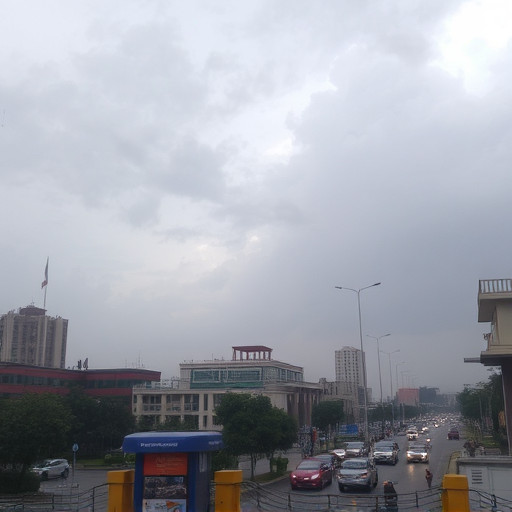
Karachi's weather is characterized by its aridity, with heavy monsoon rains occurring between June and September. The city is prone to both droughts and flooding due to the unpredictable nature of the monsoon season influenced by sea surface temperatures and atmospheric pressure systems. This week, the Met Department forecasts a mix of rainfall with varying intensities, advising residents to monitor weather updates for potential thunderstorms with strong winds and heavy rain, which could lead to localized flooding. Safety measures are crucial, including clearing drains and gutters, securing outdoor items, and preparing emergency kits. Residents should stay informed through official channels as the forecasted rainfall may vary in timing and volume. Local authorities will issue safety guidelines, emphasizing the importance of heeding weather advisories and evacuation orders when necessary to ensure safety during the unpredictable monsoon conditions.
As Karachi’s monsoon season approaches, the city’s weather forecast takes center stage in the daily lives of its inhabitants. This week’s rain predictions hold a crucial role in shaping our preparations and adaptations to the changing climate. Delving into historical weather patterns provides valuable insights that can enhance our understanding and readiness for the upcoming precipitation. Our exploration will uncover trends and tendencies, equipping residents with the foresight needed to navigate the week’s forecast effectively. From the current rain forecast predictions to preparing for potential rainfall, each aspect of the forthcoming weather will be examined, offering a comprehensive weekly outlook and highlighting essential adaptation strategies. Join us as we analyze Karachi’s rain forecast this week and ensure that your expectations align with the meticulous weather insights.
- Historical Weather Patterns in Karachi
- Current Rain Forecast Predictions
- Preparing for Potential Rainfall
- Weekly Outlook and Adaptation Strategies
Historical Weather Patterns in Karachi

Karachi, the largest city in Pakistan, is known for its arid climate, with most of its annual precipitation occurring between June and September during the monsoon season. Historically, the city’s weather patterns have demonstrated a high degree of variability. Traditionally, the city experiences hot and dry conditions for much of the year, with temperatures often soaring above 30 degrees Celsius. However, the monsoon period brings a significant shift, with heavy rains that can lead to flooding in low-lying areas. These rains are a result of the southwest monsoon currents that sweep across the Indian subcontinent, influenced by the seasonal shifts in the Indian Ocean’s sea surface temperatures and atmospheric pressure systems.
Over the years, Karachi has faced both droughts and extreme rainfall events, underscoring the unpredictability of its weather. For instance, in 2011, Karachi experienced record-breaking rains which caused widespread flooding and significant urban waterlogging issues. Conversely, prolonged dry spells have also been observed, highlighting the city’s vulnerability to both extremes. The historical data indicates a trend of increasing variability in rainfall patterns, with some years receiving significantly more precipitation than others. This variability underscores the importance of monitoring and understanding the changing weather dynamics in Karachi, particularly as climate change continues to impact global weather systems. Understanding these historical weather patterns is crucial for city planners and residents to prepare for and adapt to the unpredictable nature of Karachi’s rainfall forecast.
Current Rain Forecast Predictions

Currently, Karachi’s rain forecast for the upcoming week indicates a possibility of precipitation, with varying intensities of showers predicted over the course of the period. The Met Department has been closely monitoring the weather systems and suggests that residents should stay updated on real-time weather updates. The prevailing monsoon conditions in the region suggest that there could be isolated rainfall, which may lead to temporary disruptions but is expected to bring much-needed relief from the heat. Additionally, there’s a potential for thunderstorms, which could result in gusty winds and heavy downpours within short time spans. Residents are advised to keep an eye on weather advisories, as these conditions can change rapidly. The forecast also predicts that the humidity levels will remain high, and there might be localized flooding in low-lying areas due to intense rainfall. It is recommended that people plan their activities accordingly and take necessary precautions to ensure safety during these wet spells.
Preparing for Potential Rainfall

As Karachi braces for the week’s rain forecast, it is prudent to prepare for potential rainfall to ensure safety and minimize disruptions. Residents are advised to clear gutters and drains of any accumulated debris that could impede water flow during heavy downpours. It’s also important to secure outdoor items that could become projectiles in strong winds or be carried away by floodwaters. Ensuring that one’s living space is waterproofed, with sealed windows and reinforced roofing, will help prevent leaks and water damage. Additionally, having an emergency kit stocked with essential supplies such as food, water, batteries, and medications is a wise precautionary measure. Keeping mobile devices charged and having a plan for communication in case of power outages are equally crucial. By taking these proactive steps, residents can navigate the rainy conditions with greater ease and maintain their well-being throughout the week. It’s also advisable to stay informed through reliable weather updates and local authorities’ guidance, as weather patterns can be unpredictable and may change rapidly.
Weekly Outlook and Adaptation Strategies

The weekly outlook for Karachi’s rain forecast indicates a moderate chance of precipitation over the next seven days. Residents can expect intermittent showers, with heavier rainfall possible during the afternoons and evenings. The Humadev region, which influences South Asian weather patterns, is expected to play a significant role in determining the intensity and distribution of these rains. It’s advisable for locals to stay informed through reliable meteorological sources as timing and amounts can vary.
In preparation for potential rainfall, adaptation strategies should be implemented to mitigate the effects of heavy downpours. These include ensuring that drains and gutters are free of debris to facilitate proper water flow, which can prevent flooding in low-lying areas. Additionally, households and businesses should secure loose items outside to avoid them becoming projectiles or obstructions. Public transportation routes may be affected by the rain, so considering alternative travel options or allowing extra time for commutes is wise. Local authorities often issue safety guidelines, which citizens are encouraged to follow, including staying indoors during heavy rain and being vigilant of any weather-related advisories or evacuation orders.
This week’s rain forecast for Karachi indicates a fluctuating pattern, with predictions suggesting both dry spells and rain showers. Residents are advised to heed the current weather advisories and prepare accordingly. Historical weather patterns in the region can offer context for these fluctuations, highlighting the variability that characterizes Karachi’s climate. By reviewing past weather conditions and adopting effective adaptation strategies, the community can better cope with the upcoming changes. In summary, while precise predictions are subject to change, staying informed and prepared will aid in smoothly navigating the week’s diverse weather scenarios in Karachi.


